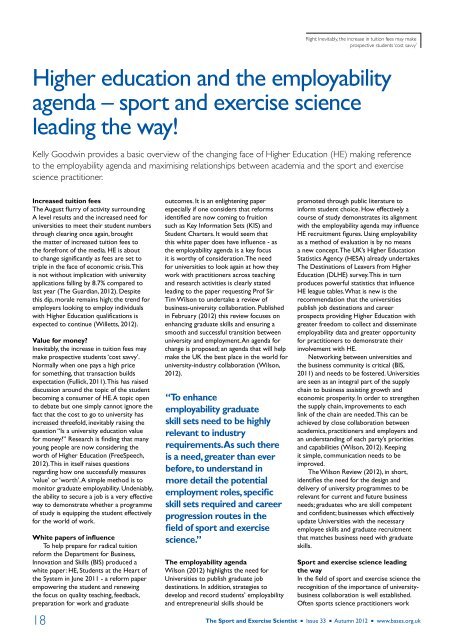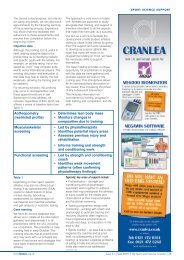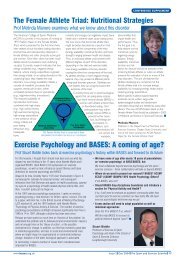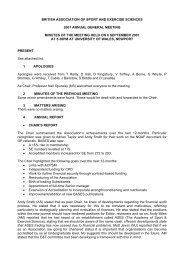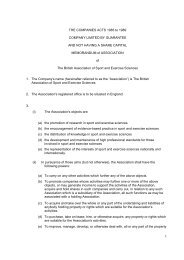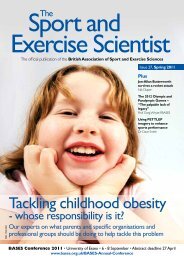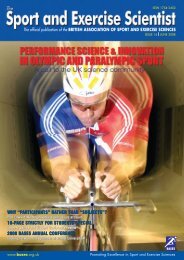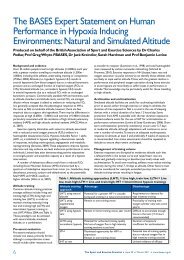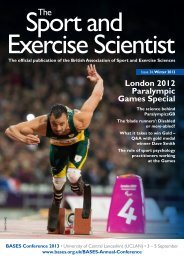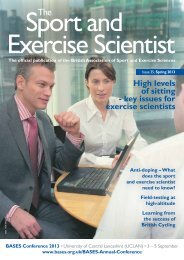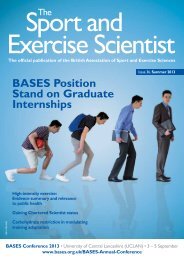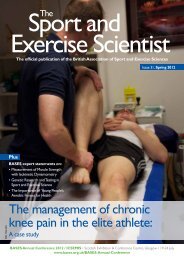Issue 33 Autumn 2012 - Bases
Issue 33 Autumn 2012 - Bases
Issue 33 Autumn 2012 - Bases
- No tags were found...
You also want an ePaper? Increase the reach of your titles
YUMPU automatically turns print PDFs into web optimized ePapers that Google loves.
Right: Inevitably, the increase in tuition fees may makeprospective students ‘cost savvy’Higher education and the employabilityagenda – sport and exercise scienceleading the way!Kelly Goodwin provides a basic overview of the changing face of Higher Education (HE) making referenceto the employability agenda and maximising relationships between academia and the sport and exercisescience practitioner.Increased tuition feesThe August flurry of activity surroundingA level results and the increased need foruniversities to meet their student numbersthrough clearing once again, broughtthe matter of increased tuition fees tothe forefront of the media. HE is aboutto change significantly as fees are set totriple in the face of economic crisis. Thisis not without implication with universityapplications falling by 8.7% compared tolast year (The Guardian, <strong>2012</strong>). Despitethis dip, morale remains high; the trend foremployers looking to employ individualswith Higher Education qualifications isexpected to continue (Willetts, <strong>2012</strong>).Value for money?Inevitably, the increase in tuition fees maymake prospective students ‘cost savvy’.Normally when one pays a high pricefor something, that transaction buildsexpectation (Fullick, 2011). This has raiseddiscussion around the topic of the studentbecoming a consumer of HE. A topic opento debate but one simply cannot ignore thefact that the cost to go to university hasincreased threefold, inevitably raising thequestion “Is a university education valuefor money?” Research is finding that manyyoung people are now considering theworth of Higher Education (FreeSpeech,<strong>2012</strong>). This in itself raises questionsregarding how one successfully measures‘value’ or ‘worth’. A simple method is tomonitor graduate employability. Undeniably,the ability to secure a job is a very effectiveway to demonstrate whether a programmeof study is equipping the student effectivelyfor the world of work.White papers of influenceTo help prepare for radical tuitionreform the Department for Business,Innovation and Skills (BIS) produced awhite paper: HE, Students at the Heart ofthe System in June 2011 - a reform paperempowering the student and renewingthe focus on quality teaching, feedback,preparation for work and graduateoutcomes. It is an enlightening paperespecially if one considers that reformsidentified are now coming to fruitionsuch as Key Information Sets (KIS) andStudent Charters. It would seem thatthis white paper does have influence - asthe employability agenda is a key focusit is worthy of consideration. The needfor universities to look again at how theywork with practitioners across teachingand research activities is clearly statedleading to the paper requesting Prof SirTim Wilson to undertake a review ofbusiness-university collaboration. Publishedin February (<strong>2012</strong>) this review focuses onenhancing graduate skills and ensuring asmooth and successful transition betweenuniversity and employment. An agenda forchange is proposed; an agenda that will helpmake the UK the best place in the world foruniversity-industry collaboration (Wilson,<strong>2012</strong>).“To enhanceemployability graduateskill sets need to be highlyrelevant to industryrequirements. As such thereis a need, greater than everbefore, to understand inmore detail the potentialemployment roles, specificskill sets required and careerprogression routes in thefield of sport and exercisescience.”The employability agendaWilson (<strong>2012</strong>) highlights the need forUniversities to publish graduate jobdestinations. In addition, strategies todevelop and record students’ employabilityand entrepreneurial skills should bepromoted through public literature toinform student choice. How effectively acourse of study demonstrates its alignmentwith the employability agenda may influenceHE recruitment figures. Using employabilityas a method of evaluation is by no meansa new concept. The UK’s Higher EducationStatistics Agency (HESA) already undertakesThe Destinations of Leavers from HigherEducation (DLHE) survey. This in turnproduces powerful statistics that influenceHE league tables. What is new is therecommendation that the universitiespublish job destinations and careerprospects providing Higher Education withgreater freedom to collect and disseminateemployability data and greater opportunityfor practitioners to demonstrate theirinvolvement with HE.Networking between universities andthe business community is critical (BIS,2011) and needs to be fostered. Universitiesare seen as an integral part of the supplychain to business assisting growth andeconomic prosperity. In order to strengthenthe supply chain, improvements to eachlink of the chain are needed. This can beachieved by close collaboration betweenacademics, practitioners and employers andan understanding of each party’s prioritiesand capabilities (Wilson, <strong>2012</strong>). Keepingit simple, communication needs to beimproved.The Wilson Review (<strong>2012</strong>), in short,identifies the need for the design anddelivery of university programmes to berelevant for current and future businessneeds; graduates who are skill competentand confident; businesses which effectivelyupdate Universities with the necessaryemployee skills and graduate recruitmentthat matches business need with graduateskills.Sport and exercise science leadingthe wayIn the field of sport and exercise science therecognition of the importance of universitybusinesscollaboration is well established.Often sports science practitioners work18 The Sport and Exercise Scientist n <strong>Issue</strong> <strong>33</strong> n <strong>Autumn</strong> <strong>2012</strong> n www.bases.org.uk


